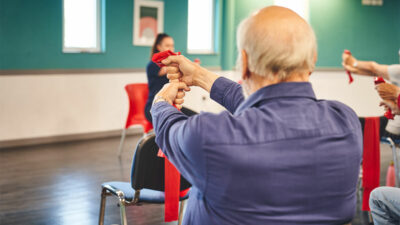

The Power of Grip Strength and Why It Matters for Health
Grip strength is a simple yet powerful sign of overall health, independence, and ageing well. Learn how to test and improve it at home.


Grip strength is a simple yet powerful sign of overall health, independence, and ageing well. Learn how to test and improve it at home.
When we think about good health, we often focus on heart function, lung capacity, or cholesterol levels. Yet one of the most overlooked indicators of wellbeing is grip strength. It might sound like a small detail, but it reveals a lot about how our bodies are ageing and performing. At iCareiMove, we have been using grip strength as a health measure for years, and there is a very good reason why.
Let’s take Joan as an example. She recently joined our Wobbly programme, which supports older adults in ageing well. Joan is 78 years old and has a few health conditions that make her unsteady on her feet. If we were assessing a younger adult, we might use a step test, a body composition scan, or a one repetition maximum test. For Joan, those would not be safe or meaningful. Instead, we used grip strength, which gave us valuable insight into her physical ability in a simple and safe way.
Grip strength is about more than how firmly someone can shake your hand. It is linked to a wide range of health factors, including cardiovascular disease, stroke, diabetes, obesity, and cognitive decline. For Joan, measuring grip strength told us more than charts and statistics ever could. It showed that she could still open her milk bottle, button her cardigan, use her hairdryer, and lock her front door. These everyday actions are powerful signs of independence and quality of life.
As we age, we naturally lose muscle mass and nerve function. A weakening grip often signals a decline in fine motor skills such as pinching, twisting, and holding. When these abilities fade, the risk of accidents, falls, and fractures increases, which can quickly lead to physical decline. Grip strength is therefore about more than muscle power; it represents safety, independence, and longevity.
Strong grip strength supports better functional fitness and makes daily life easier. Tasks such as opening jars, carrying groceries, walking the dog, or using mobility aids all become more manageable. For many older adults who value independence, maintaining a firm grip means maintaining freedom. It allows them to get dressed, enjoy their hobbies, and move through life with confidence. Helping someone preserve their grip strength is also helping them hold on to what matters most, whether that is lifting a shopping bag, holding a cup of tea, or clipping on a dog’s lead.
You do not need specialist equipment to start paying attention to grip strength. A dynamometer is useful for professionals, but you can also monitor small changes in daily life. If jars are harder to open or shopping feels heavier, your body is sending you a signal. Even carrying a soft stress toy and squeezing it throughout the day can be surprisingly effective.
There are also easy exercises you can do at home:
When thinking about health, do not forget your hands. Grip strength may seem small, but it is one of the clearest indicators of how well we are ageing and how capable we are of living independently. Small daily actions can make a big difference. By giving your hands a little extra attention, you are investing in strength, independence, and a more active future. So go ahead and give something a squeeze today. You might be surprised by how much it reveals about your overall health.